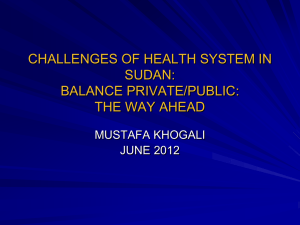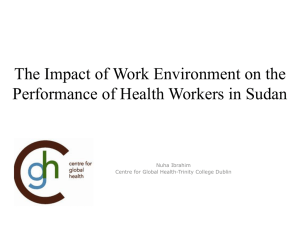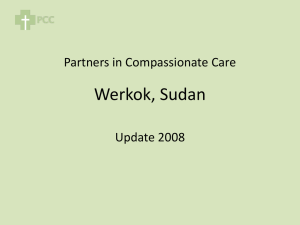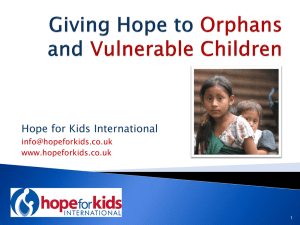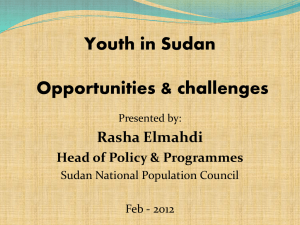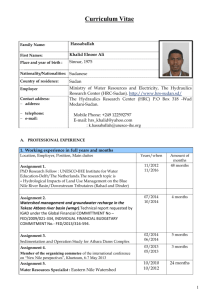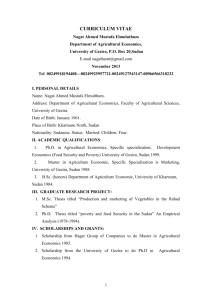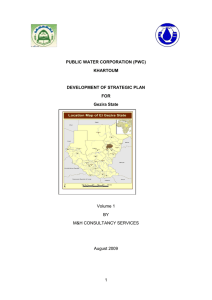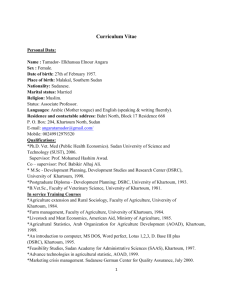Situation of Health services and Medical Education in
advertisement
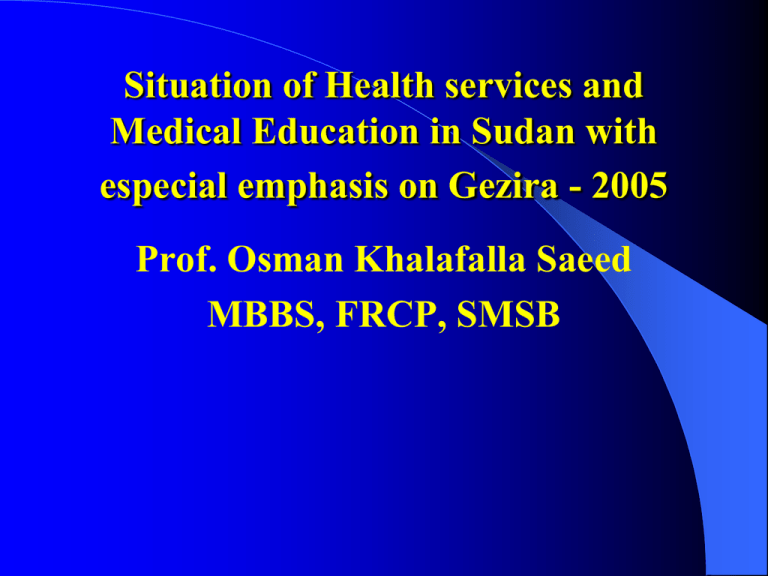
Situation of Health services and Medical Education in Sudan with especial emphasis on Gezira - 2005 Prof. Osman Khalafalla Saeed MBBS, FRCP, SMSB The Republic of Sudan GEOGRAPHY • Sudan is the largest country in Africa (1000000 mile2) • Lies between lat 4 to 22 N, long 22 to 38 East. • Borders with 9 countries. • The Blue Nile & White Nile join at Khartoum and the main Nile runs through the country up to Egypt. Sudan is divided into four climatic regions: a. The Red Sea coastal strip. b. Northern Sudan (north of latitude 19° N). c. Central Sudan (between latitudes 19° N and 13° N). d. Southern Sudan (south of latitude 13° N). Demography: Population 32.7m (7.5m in Khartoum) 1. Population growth rate 2.63% . 2. 63.2% rural, 34.8% urban. 3. Majority along the rivers 4. Internal migration towards the cities. 5. Under 15 years 45.04%, above 60 3.9%. 6. Infant Mortality Rate 80/1000 live birth. 7. Maternal Mortality Ratio 350/100000. Economy Agriculture 1. The main source of Sudanese economy. 2. The irrigated schemes are the backbone of the economy (Gezira, Rahad,Kenana,etc). 3. Arabic Gum 80% of the world product. 4. Animal wealth in Sudan is immense: - Cattle 33 millions. - Sheep 40 millions. - Goats 36 millions. - Camels 3 millions. Economy Industry Share of industrial production is only 9%. Potential of hydro-electric power in Sudan is great but exploitation is low. Railway, sea, river and air transport are completely state owned. OIL is becoming the backbone of the economy. History of Health Services in Sudan 1. 2. 3. 4. 5. 6. 7. 8. 9. 10. 1899 Began with the Anglo Egyptian Condominium. Followed by Egyptian Army Medical Corp (E.A.M.C) Then Royal Army Medical Corps (RAMC) 1901-1902 British doctors arrived in Sudan 1904-1908 six British doctors, 30 Syrian doctors 1908-1924 Modern Medical Service 1924-1948 Sudan Medical Service 1930 first batch of Sudanese doctors from Kitchner Medical School 1925 there were 20 hospitals, 65 dispensaries 1965 73 hospitals, 62 health centres and 244 dispensaries Health Services Up to 2005: No. of hospitals 375 No. of beds 26094 Teaching hospitals 89 Health centres 1043, Rural 485, urban 558 Dispensaries 1475 Dressing stations 2404 Blood banks 63 No.of doctors in 2005: Total number 8008: Specialist 1261, Registrar 591, Dentists 471, Pharmacists 894 The increase in the health services in the last 10 years is about 30%. Situation in Gezira State where the University is Located 2005 population 3905000 (12%) 52 hospitals (14.2%) 214 health centres (23.4%) 264 dispensaries (17.9%) 390 dressing stations (31.6%) 44 primary care unit 123 specialist- doctors: University 48, Ministry of health 75 337 medical officers 70 pharmacist 21 dentists Health services in Gezira State The health services in Gezira state is provided through teaching hospitals, rural hospitals and health centres. The teaching hospitals are mainly located in Wad Medani town, they are Wad Medani Teaching Hospital Wad Medani Maternity Hospital Wad Medani Paediatrics Teaching Hospital Wad Medani Dermatology Teaching Hospital Elsayem Eye hospital Wad Medani Hospital of Renal Diseases and Surgery Radiotherapy an Oncology hospital Medical Education 1924 Kitchner Medical School in Khartoum Now Faculty of Medicine University of Khartoum. 1978 Juba Medical School 1978 Gezira Medical School 2005 30 Medical Schools (23 government, private 7) 1977 Postgraduate Medical Education. Gezira Medical School 1. 2. 3. 4. 5. 6. 7. 8. 9. Annual intake 250. Community Oriented Education. Problem Based Learning. Community Based Learning Integrated system Student centered education Team work Nationally and Internationally effective Winner of the Prize for the best medical school in the Arab world year 2002 (offered by Sheikh Hamdan Bin Rashid Al Maktoom, UAE). Faculty of Medicine University of Gezira Curriculum Features: 1. 2. 3. 4. It’s ACOME programme 10 semesters -5 calendar years-249 credit hours. Block system (courses). All courses include activities learned in community sites (PHC Units Rural Hospitals ,Villages, Families, and factories) Total number of medical officers needs for the next 10 years 11770 Expected graduated of medical schools in 2013 would be 17778 Specialists needed 2004 -2013 is 5652 Expected graduates 5500 Sub-specialists need for the next ten years 739 Expected graduate 200 Common Medical Problems - 2005: 1. Malaria 2. Diarrhea diseases : Children 1050927, Adults 148753 3. Upper respiratory tract infection 4. Malnutrition 5. Anaemia 6. Bilharzia 7. Viral hepatitis 8. Heart disease 9. Tuberculosis 10. Diabetes meltites 11. Cancer The ten Leading Causes of Death 1. 2. 3. 4. 5. 6. 7. 8. 9. 10. Malaria Heart disease Pneumonia Diarrhea diseases Septicemia Anaemia Cancer Tuberculosis Renal failure Viral hepatitis History of Medical Research 1903 – 1932 Wellcome Tropical Research Laboratories 1902 Mr. Wellcome donated equipments for a research laboratory as a gift to Sudan Government. 1903 SIR Andrew Bolfour commenced the work at the Wellcome Tropical Research Laboratories in Khartoum. First research was in Malaria. 1919 first 70 cases of Bilharzia were treated by Tartar emetic (this is one of the most important contribution from Sudan to the history of medicine). 1927 new laboratories (Sir. Lee Stack governor general of Sudan who was assassinated in Cairo 1924. 1936 malaria research by Bedford. 1943 yellow fever 1944 –1952 Prof. Haseeb first Sudanese director of Stack laboratories. 1960 United States novel medical research unit no. 3 NAMRU3 epidemiology of visceral leishmaniasis (Kala Azar) in Sudan. 1963 Dr. Satti pioneer in research, established Sudan Medical Research Council to organize medical research work.. 1963 Sudan Medical Journal for research publications. 1964 Sir. Graham Wilson ex-director of public health laboratories of England and Wales was invited to visit Sudan to advise on laboratory and research work. 1970 National Public Health Laboratories 1970 National Council for Research 1972 Medical research Council 1972 Institute for Tropical Medicine 1972 –2000 several research units Target Diseases: Poverty Related Diseases (PRD) in Gezira: 1. Malaria 2. Schistosomiasis Bilharzia 3. Diarrheal diseases 4. Tuberculosis TB Other communicable diseases: Typhoid fever Brucellosis 3. Streptococcal infection. 4. Intestinal parasites 1. 2. Current Medical/Health Research in Gezira University 1. 2. 3. 4. 5. 6. 7. 8. 9. 10. Schistosomiasis (epidemiology, pathology, immunology, genetics and control). Malaria (epidemiology diagnosis, drug resistance and control). Leishmaniasis project (diagnosis). Maternity and childhood health (safe motherhood). Evaluation of health services in the community. Impact of Gezira Medical School in the health services (students role). Cancer research (epidemiology and genetics). TB (diagnosis and pharmaco-epidemiology). HIV and viral hepatitides. Traditional healing.
